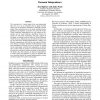Free Online Productivity Tools
i2Speak
i2Symbol
i2OCR
iTex2Img
iWeb2Print
iWeb2Shot
i2Type
iPdf2Split
iPdf2Merge
i2Bopomofo
i2Arabic
i2Style
i2Image
i2PDF
iLatex2Rtf
Sci2ools
AAAI
2008
2008
Dormant Independence
The construction of causal graphs from non-experimental data rests on a set of constraints that the graph structure imposes on all probability distributions compatible with the graph. These constraints are of two types: conditional independencies and algebraic constraints, first noted by Verma. While conditional independencies are well studied and frequently used in causal induction algorithms, Verma constraints are still poorly understood, and rarely applied. In this paper we examine a special subset of Verma constraints which are easy to understand, easy to identify and easy to apply; they arise from "dormant independencies," namely, conditional independencies that hold in interventional distributions. We give a complete algorithm for determining if a dormant independence between two sets of variables is entailed by the causal graph, such that this independence is identifiable, in other words if it resides in an interventional distribution that can be predicted without res...
| Added | 02 Oct 2010 |
| Updated | 02 Oct 2010 |
| Type | Conference |
| Year | 2008 |
| Where | AAAI |
| Authors | Ilya Shpitser, Judea Pearl |
Comments (0)

